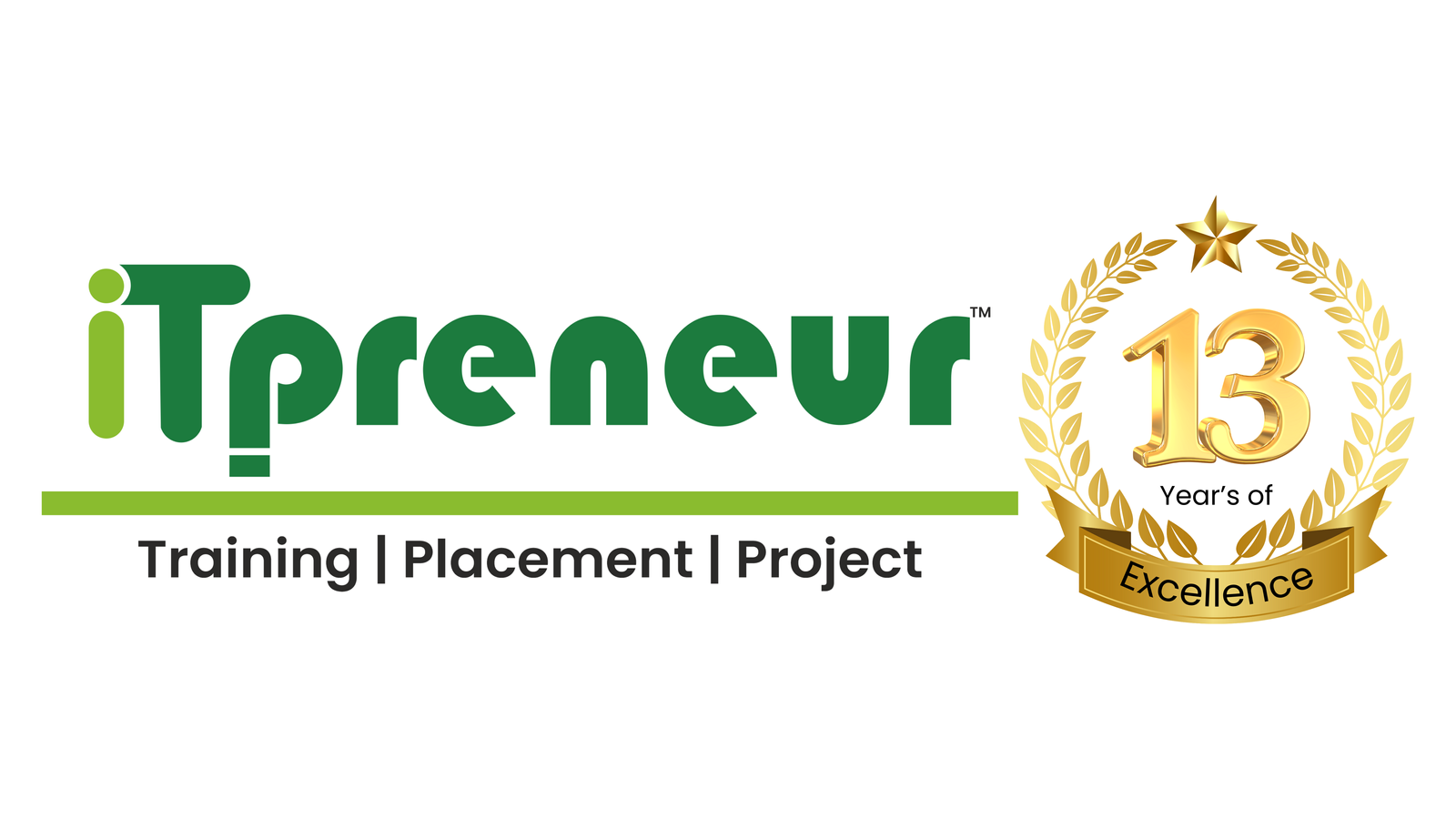Kickstart Your Tech Career: Why Full Stack .NET Development is Perfect for Fresh Graduates in 2025
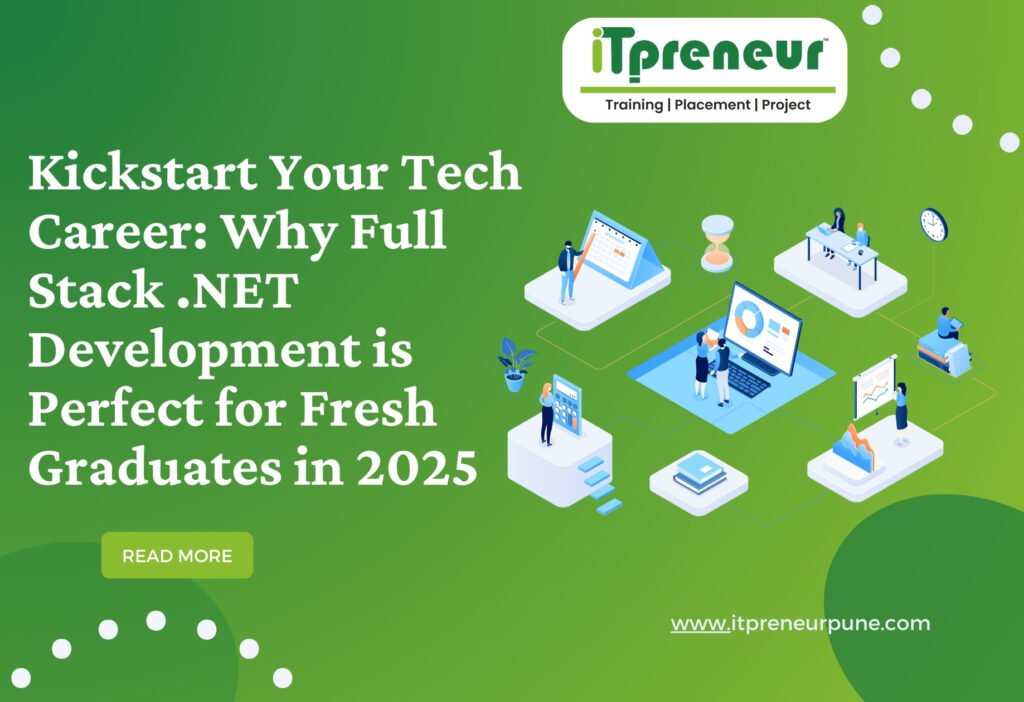
Why .NET Full Stack Development Is the Best Career Choice in 2025 Introduction In 2025, the demand for .NET Full Stack Developers is at an all-time high. Whether you’re just starting out or an experienced developer, mastering .NET web development can open doors to high-paying jobs, freelancing opportunities, and even your own startup. But what makes .NET so powerful for full stack development? Let’s dive into why you should consider learning it and how you can stay ahead in the tech world. What is .NET Full Stack Development? A .NET Full Stack Developer is proficient in both backend development with .NET Core and frontend technologies like React or Angular. This allows them to build fully functional, scalable web applications from scratch. A typical .NET Full Stack stack includes: ✅ Backend: ASP.NET Core, C# 12, Microservices Architecture, RESTful APIs, gRPC with .NET✅ Frontend: React with .NET Backend, Angular with .NET, Blazor, HTML/CSS/JavaScript✅ Databases: SQL Server, PostgreSQL, MongoDB with .NET✅ Deployment & DevOps: Docker with .NET, Kubernetes for .NET Apps, Azure DevOps, CI/CD Pipelines Why Learn .NET Full Stack in 2025? 🔥 1. High Demand for .NET Developers.NET remains one of the most widely used frameworks in 2025, powering enterprise applications, cloud solutions, and modern web apps. 🚀 2. Power of .NET FrameworksFrameworks like ASP.NET Core and Blazor simplify development and make it easier to build RESTful APIs and microservices architecture solutions that scale efficiently. ☁ 3. Cloud & DevOps IntegrationWith cloud computing on the rise, skills in Docker with .NET, Kubernetes for .NET Apps, and CI/CD Pipelines (Azure DevOps, GitHub Actions) are essential for modern developers. 🛡 4. Security & Performance OptimizationSecurity is a major concern for businesses. Learning ASP.NET Identity & Authentication helps secure applications, while performance optimization techniques ensure high efficiency. 💡 5. AI & Machine Learning in Web AppsWith AI becoming an essential part of modern applications, knowledge of AI and Machine Learning integration with .NET is a valuable skill for future-proofing your career. How to Become a .NET Full Stack Developer in 2025 1️⃣ Master Backend Technologies – Learn ASP.NET Core, RESTful APIs, and Microservices Architecture2️⃣ Frontend Development – Use React with .NET Backend or Angular with .NET for interactive UIs3️⃣ Database Management – Get familiar with SQL Server, PostgreSQL, and MongoDB with .NET4️⃣ DevOps & Cloud – Deploy apps using Docker, Kubernetes, and CI/CD Pipelines5️⃣ Real-Time Data Processing – Work with SignalR for Real-Time Data Streaming6️⃣ Event-Driven Development – Build Event-Driven .NET Applications with cutting-edge frameworks Final Thoughts The future of .NET in web development is brighter than ever. With skills in .NET Full Stack Development, you can land high-paying jobs, build scalable applications, and stay ahead in the tech industry. Whether you’re aiming to become a software engineer, freelancer, or entrepreneur, .NET is the perfect framework to master in 2025. Looking for the best courses to kickstart your journey? Itpreneur Pune offers industry-leading .NET Full Stack Developer courses that will help you land your first job with confidence. Ready to start your journey? 🚀 Learn Full Stack .NET Development today and future-proof your career!
Why Do Some Students Fail to Get IT Jobs? (And How to Avoid It)

Introduction:Breaking into the IT industry can be challenging, especially for freshers. While the demand for skilled IT professionals is high, many students struggle to secure their dream jobs. This blog explores the common reasons behind these challenges and provides actionable tips to ensure you don’t fall into the same pitfalls. 1. Lack of Practical Knowledge 2. Poor Communication Skills 3. Insufficient Technical Skills 4. Not Preparing for Interviews 5. Weak Resume or Portfolio 6. Lack of Networking 7. Unrealistic Salary Expectations How to Avoid These Mistakes: Conclusion:Failing to secure an IT job is not the end of the road—it’s an opportunity to learn and grow. By addressing these common mistakes and proactively preparing yourself, you can significantly increase your chances of landing your dream IT job.
From Novice to Ninja: A Complete Guide to Python Programming
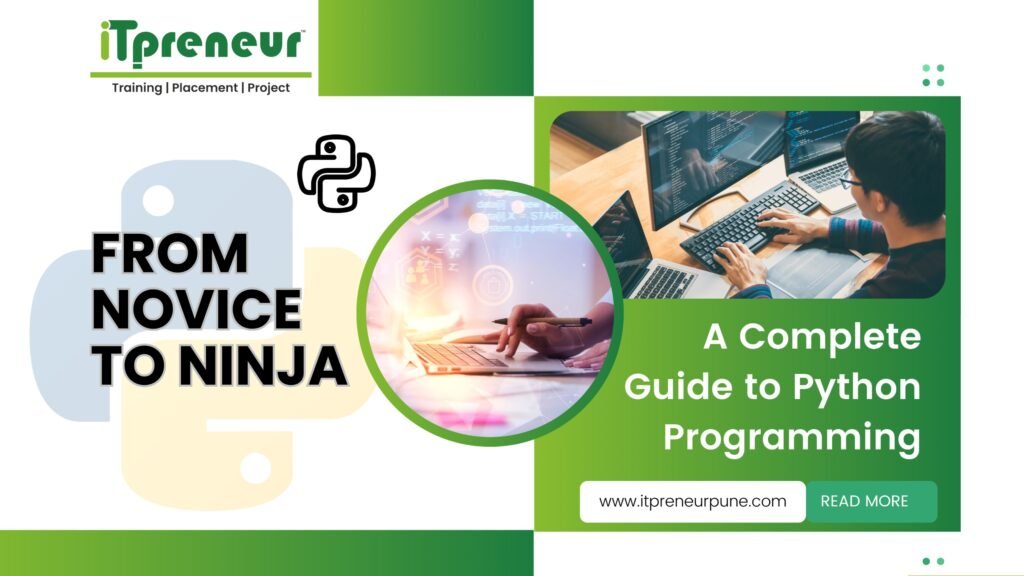
Python has emerged as one of the most powerful and versatile programming languages in the world. Its ease of use, extensive libraries, and wide range of applications make it the ideal choice for beginners and experts alike. Whether you’re looking to automate tasks, develop web applications, dive into AI and machine learning, or analyze big data, Python is the key to unlocking limitless opportunities. In this comprehensive guide, we’ll take you from a complete beginner to an advanced Python ninja, ensuring you master the language and become career-ready in no time. Why Learn Python? Python’s popularity is not just hype—it is backed by practical benefits:✅ Beginner-Friendly Syntax – Python’s readability makes it an excellent first programming language.✅ Vast Community Support – Python has one of the largest developer communities, ensuring extensive learning resources.✅ Diverse Applications – Used in web development, data science, AI, automation, and cybersecurity.✅ Highly In-Demand – Companies across industries, including Google, Facebook, and Netflix, actively seek Python developers. Step-by-Step Roadmap to Mastering Python 1. Understanding the Basics Before jumping into complex projects, start with the basics: 2. Exploring Data Structures Efficient coding requires mastering Python’s built-in data structures: 3. Mastering Libraries & Frameworks Python’s power comes from its vast ecosystem of libraries: 4. Working on Real-World Projects Build hands-on experience with real-world projects, such as:✅ Automating tasks with Python scripts✅ Developing a web application using Django✅ Creating a chatbot with AI and NLP✅ Data visualization and analysis 5. Engaging with the Python Community Join coding forums, contribute to open-source projects, and participate in hackathons to refine your skills. Conclusion The journey from a Python novice to a ninja requires patience, continuous learning, and hands-on practice. Python is not just a programming language—it is a gateway to future-proof careers in technology. By mastering Python, you open doors to endless possibilities, whether in software development, AI, finance, or automation. Start learning today and become an expert in one of the most powerful languages in the world!
Web Development vs. Mobile App Development:
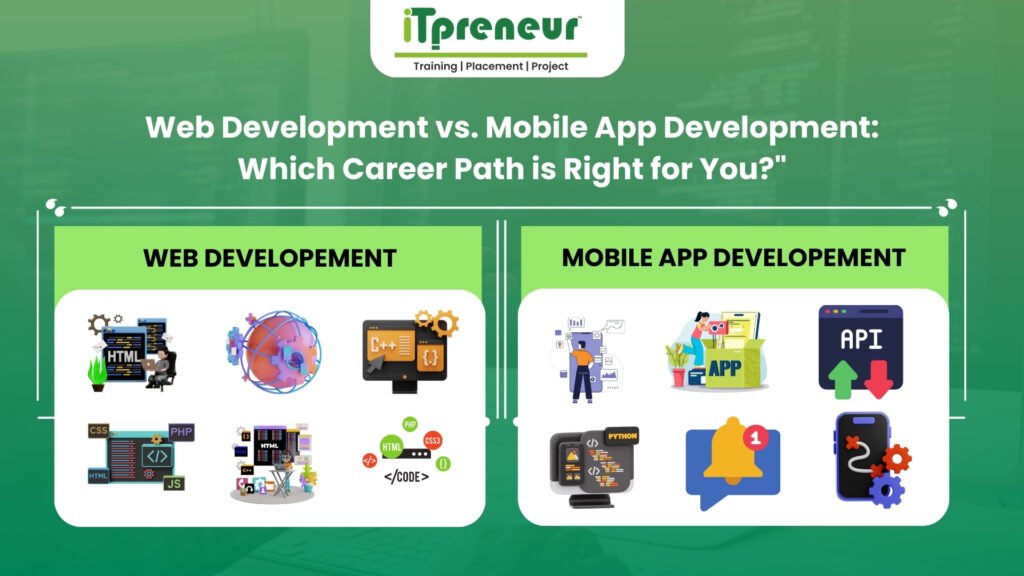
Which Career Path is Right for You?” IT professionals face the crucial decision of choosing between web and mobile development as their career path. Web development focuses on building accessible websites and applications using languages like HTML, CSS, and JavaScript, offering flexibility and continuous learning opportunities. In contrast, mobile development involves creating applications for smartphones and tablets, emphasizing user engagement and innovation with technologies like AR and IoT.y considering your interests, the job market, your current skills, career growth opportunities, and the work environment, you can make an informed choice that aligns with your goals. Understanding of Web DevelopementWeb DevelopmentWeb development is the process of creating and maintaining websites and web applications, essential for establishing an online presence. It consists of front-end development, which focuses on the user interface, and back-end development, which handles server-side logic and databases. Full-stack developers possess skills in both areas. Web development also emphasizes responsive design for various devices, security measures to protect sites, and search engine optimization to improve visibility. Combining creativity with technical expertise, web development is a vital part of the digital landscape.. Understanding the App DevelopementApp DevelopementApp development is the process of designing, creating, and maintaining applications for mobile devices, tablets, and desktops. It involves several stages, including planning, coding, testing, and deployment. Developers can create native apps, designed specifically for a particular operating system (like iOS or Android), or cross-platform apps, which function on multiple platforms using shared code. The development process typically utilizes programming languages such as Swift for iOS, Java or Kotlin for Android, and frameworks like React Native for cross-platform solutions. With the increasing reliance on mobile devices and software applications, app development has become essential for businesses seeking to engage users and enhance their digital presence. Factors to Consider When Choosing
How to Become a Python Full Stack Developer in 2025
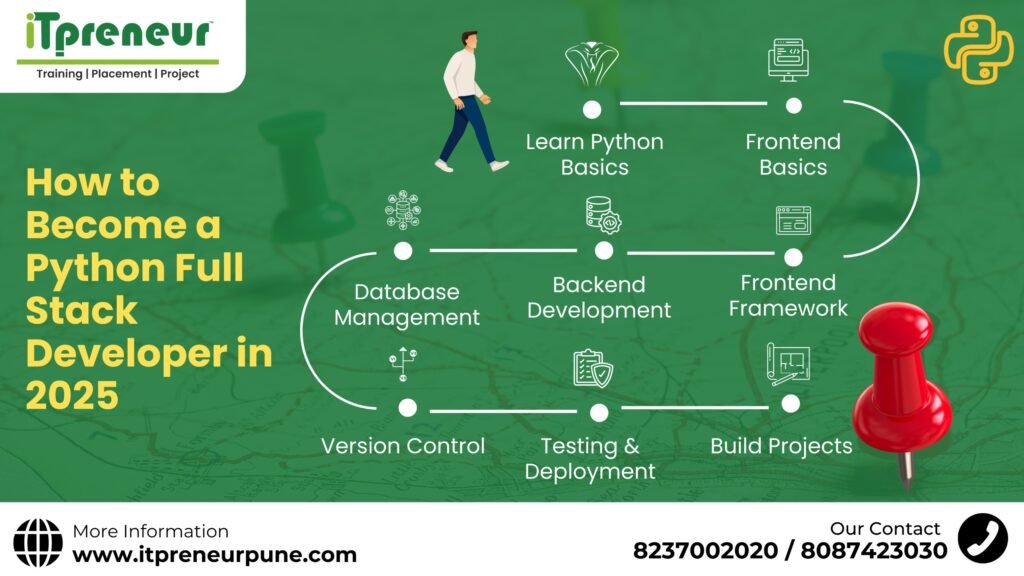
Roadmap for Python Full Stack Development In today’s digital landscape, the demand for skilled full-stack developers is at an all-time high. Python, being one of the most versatile and beginner-friendly programming languages, has become a top choice for aspiring developers. This blog outlines a clear roadmap for mastering Python Full Stack Development, breaking it down into actionable steps. Step 1: Learn Python Basics The foundation of your journey begins with understanding Python syntax and core concepts. Start by learning: 💡 Tip: Use resources like online tutorials, coding platforms, and exercises to build your foundational knowledge. Step 2: Frontend Basics To become a full-stack developer, mastering the frontend is essential. Learn the core web technologies: 💡 Tip: Focus on building simple static websites to practice. Step 3: Database Management Understanding how to store, retrieve, and manage data is critical. Learn about: 💡 Tip: Practice designing and implementing database schemas for small projects. Step 4: Backend Development Once you’re comfortable with Python, move on to backend development. Learn: 💡 Tip: Start by creating a basic CRUD application to understand backend operations. Step 5: Frontend Framework Modern web applications require dynamic and responsive designs. Learn a frontend framework like: 💡 Tip: Integrate your frontend framework with your Python backend for a complete full-stack experience. Step 6: Version Control Version control systems are essential for managing code changes and collaboration. Learn to use: 💡 Tip: Practice by contributing to open-source projects or managing your own codebase. Step 7: Testing & Deployment Learn to test and deploy your applications effectively: 💡 Tip: Build a CI/CD pipeline to automate testing and deployment. Step 8: Build Projects Finally, apply your knowledge by working on real-world projects: 💡 Tip: Building projects will not only enhance your skills but also make your portfolio stand out. Conclusion The journey to becoming a Python Full Stack Developer is both challenging and rewarding. Follow this roadmap step by step, and you’ll be well on your way to building modern, scalable web applications. At Itpreneur, we provide the best training, placement support, and hands-on projects to help you achieve your career goals in Python Full Stack Development.
Full Stack Developer Skills: A Comprehensive Guide
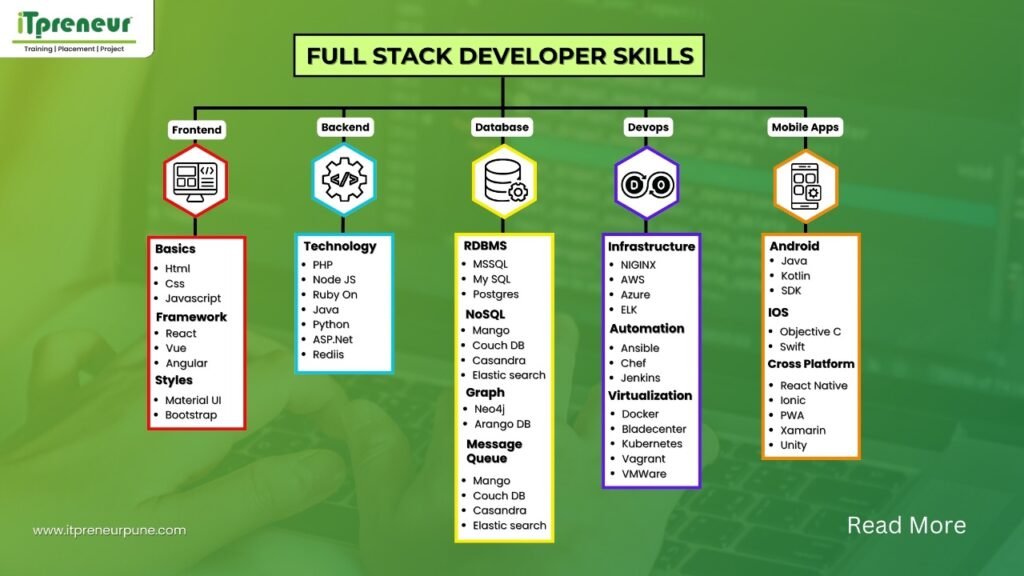
In the ever-evolving world of technology, Full Stack Development has become one of the most sought-after skills in the IT industry. A Full Stack Developer is proficient in both frontend and backend technologies, along with databases, DevOps practices, and mobile app development. This blog provides a detailed breakdown of the essential skills required to excel as a Full Stack Developer. Frontend development focuses on the user interface (UI) and user experience (UX) of web applications. This is what users see and interact with. Basics: HTML (HyperText Markup Language): The backbone of web content structure. CSS (Cascading Style Sheets): Controls the layout, colors, and fonts. JavaScript: Adds interactivity and dynamic behavior to web pages. Frameworks: React: A JavaScript library for building user interfaces. Vue: A progressive JavaScript framework for building UIs. Angular: A TypeScript-based framework for building dynamic web apps. Styles: Material UI: A popular React UI framework with pre-built components. Bootstrap: A CSS framework for responsive, mobile-first front-end development. Backend development handles the server-side logic, database interactions, and application architecture. Technologies: PHP: A server-side scripting language. Node.js: JavaScript runtime for building scalable network applications. Ruby on Rails: A framework for building web applications in Ruby. Java: A versatile programming language used for enterprise-level applications. Python: Widely used for web development, automation, and AI. ASP.NET: A framework for building web apps with .NET. Redis: An in-memory data structure store for caching and databases. Databases store and manage data efficiently. Full Stack Developers should understand both relational and non-relational databases. RDBMS (Relational Database Management Systems): MSSQL, MySQL, Postgres: Popular relational databases used for structured data. NoSQL Databases: MongoDB, CouchDB, Cassandra, Elasticsearch: Handle unstructured and semi-structured data. Graph Databases: Neo4j, ArangoDB: Designed for managing and querying graph-based data. Message Queues: MongoDB, CouchDB, Cassandra, Elasticsearch: Used for asynchronous communication between services. DevOps ensures smooth deployment, monitoring, and scaling of applications. Infrastructure: NGINX: A high-performance web server and reverse proxy. AWS, Azure: Leading cloud service providers. ELK Stack (Elasticsearch, Logstash, Kibana): Used for log management and analysis. Automation Tools: Ansible, Chef, Jenkins: Automate software deployment and infrastructure management. Virtualization: Docker, Bladecenter, Kubernetes, Vagrant, VMWare: Manage containers, virtual machines, and cloud infrastructure. Mobile development skills are essential for building apps for Android, iOS, and cross-platform environments. Android Development: Java, Kotlin, SDK (Software Development Kit): Core technologies for Android apps. iOS Development: Objective-C, Swift: Programming languages for Apple devices. Cross-Platform Development: React Native, Ionic, PWA (Progressive Web Apps), Xamarin, Unity: Frameworks for building apps that run on both Android and iOS. Conclusion Becoming a Full Stack Developer requires a blend of frontend, backend, database management, DevOps, and mobile development skills. Mastering these technologies will open doors to diverse opportunities in the tech industry. Whether you’re building web applications, managing cloud infrastructure, or developing mobile apps, Full Stack Development equips you with the versatility to thrive in the digital world. Ready to become a Full Stack Developer? Start your journey with ITpreneur today!
Full Stack Development vs. Software Testing: Which IT Career is Right for You?
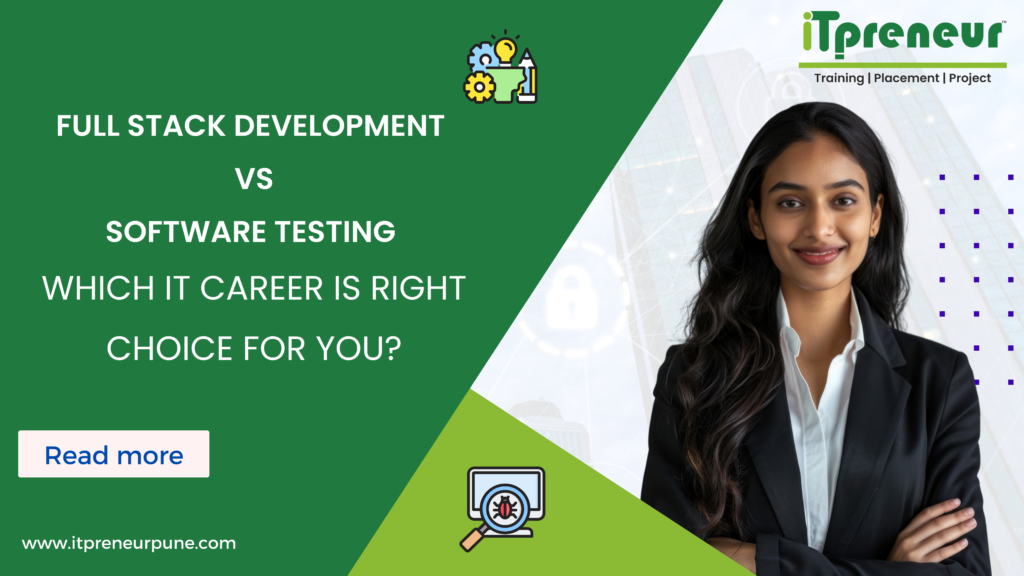
Choosing the right career path in IT can be a daunting task. With so many exciting opportunities, how do you decide which is the best fit for your skills and aspirations? Two popular career options are Full Stack Development and Software Testing, but which one is right for you? In this blog, we’ll break down both career paths, highlighting the skills required, job roles, salary potential, and growth opportunities, so you can make an informed decision about your future. What is Full Stack Development? Full Stack Development refers to the practice of building both the front end and back end of web applications. Full Stack Developers are proficient in both user-facing and server-side technologies, making them highly valuable in the software development world. Skills Required for Full Stack Development Frontend: HTML, CSS, JavaScript, React.js, Angular Backend: Node.js, Python, Ruby, Java, .NET Databases: MySQL, MongoDB, PostgreSQL Version Control: Git, GitHub Deployment & Cloud: AWS, Docker, Kubernetes Who Should Choose Full Stack Development? People who love coding and problem-solving Those interested in working with both frontend and backend technologies Developers who enjoy creating end-to-end solutions Job Roles & Salary Junior Full Stack Developer: ₹4-6 LPA Full Stack Developer: ₹6-12 LPA Senior Full Stack Engineer: ₹12+ LPA Why Full Stack Development is a Great Career Choice High Demand: Full Stack Developers are in demand because they can handle multiple aspects of software development. Lucrative Salary: Due to the breadth of skills required, Full Stack Developers often command higher salaries. Career Growth: With experience, you can move into leadership roles like Tech Lead or Engineering Manager. What is Software Testing? Software Testing is a crucial phase in software development. Testers ensure that applications are free from bugs, perform well, and meet user expectations. While Full Stack Developers build applications, Software Testers ensure those applications work as intended. Skills Required for Software Testing Manual Testing: Functional Testing, Regression Testing Automation Testing: Selenium, Appium, JMeter Bug Tracking: JIRA, Bugzilla Performance Testing: LoadRunner Test Management: Agile & Scrum Who Should Choose Software Testing? Individuals with a keen eye for detail and problem-solving People who enjoy finding errors and improving product quality Those who prefer working with a structured, methodical approach Job Roles & Salary Software Tester: ₹3-5 LPA QA Engineer (Automation): ₹5-8 LPA QA Lead/Manager: ₹8-12 LPA Why Software Testing is a Great Career Choice High Demand: As more companies adopt Agile and DevOps, the need for skilled testers grows. Easy Entry into IT: Software Testing requires less coding experience, making it ideal for non-programmers entering IT. Job Stability: QA roles are always in demand because every software application needs testing before release. Full Stack Development vs. Software Testing: Which is Right for You? Choosing between Full Stack Development and Software Testing depends on several factors, including your interests, skills, and long-term goals. Here’s a quick comparison to help you decide: Which Career Path Should You Choose? Go for Full Stack Development if: You love coding and building applications You enjoy working with both frontend and backend technologies You’re looking for a career with high earning potential and opportunities for advancement Go for Software Testing if: You have a keen eye for detail and enjoy ensuring software quality You prefer a more structured work style with clear processes You’re looking for a career that offers stability and easy entry into the IT industryConclusion Both Full Stack Development and Software Testing are excellent career choices in the IT industry, each offering unique opportunities. Full Stack Development is ideal for those who want to build software from the ground up and work on a wide range of technologies. On the other hand, Software Testing is perfect for individuals who enjoy ensuring quality, discovering bugs, and maintaining high standards in software development. Ultimately, the best choice depends on your interests, strengths, and long-term career goals. Whatever path you choose, there’s no doubt that the IT industry is full of high-paying, rewarding opportunities for both developers and testers. Are you ready to kickstart your IT career in 2025? Choose the path that aligns with your skills and passion, and begin your journey to success today!
Fast-Track Your Coding Career with Itpreneur’s Full Stack Python Course
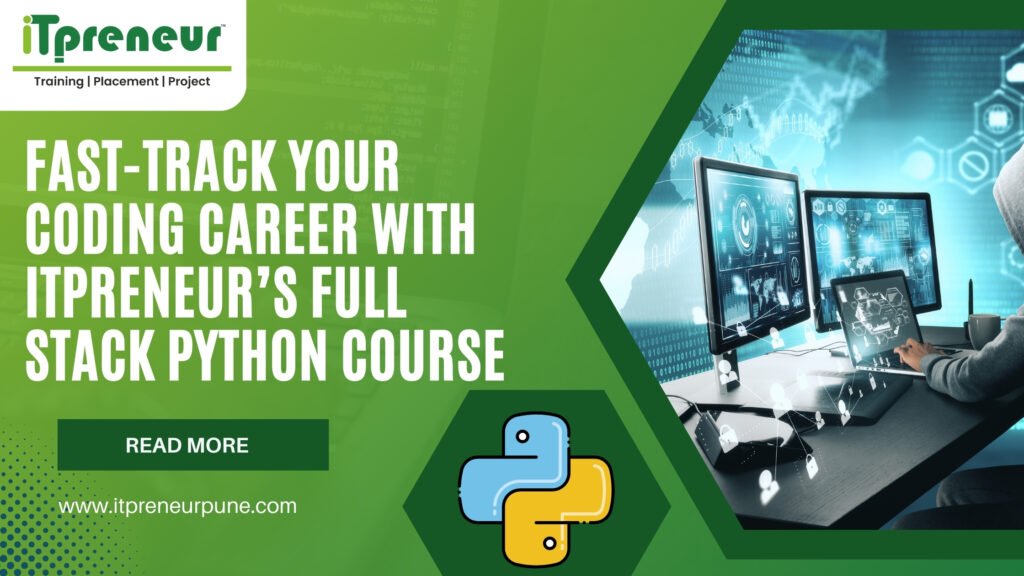
Introduction In 2025, the demand for Full Stack Python Developers is skyrocketing. Whether you’re a beginner or an experienced coder, mastering Python web development can open doors to high-paying jobs, freelancing opportunities, and even your own startup. But what makes Python so powerful for full stack development? Let’s dive into why you should consider learning it and how you can stay ahead in the tech world. What is Full Stack Python Development? A Full Stack Python Developer is proficient in both backend development with Python and frontend technologies like React.js or Vue.js. This allows them to build fully functional applications from scratch. A Full Stack Python stack typically includes:✅ Backend: Django Framework, Flask Microservices, FastAPI Development✅ Frontend: React & Python, HTML/CSS/JavaScript✅ Databases: PostgreSQL & Python, MongoDB with Python✅ Deployment & DevOps: Docker & Kubernetes for Python, Cloud Deployment with Python Why Learn Full Stack Python in 2025? 🔥 1. High Demand for Python Developers Python is the most popular programming language in 2025, widely used in API development with Python, machine learning, and web applications. 🚀 2. Power of Python Frameworks Frameworks like Django, Flask, and FastAPI make it easy to build secure and scalable web applications. Companies prefer Django for RESTful APIs with Django & Flask due to its built-in security features. ☁️ 3. Cloud & DevOps Integration As businesses shift to cloud solutions, DevOps for Python Developers is a highly valued skill. You can deploy Python applications using serverless architectures and tools like Docker & Kubernetes for Python. 🛡️ 4. Cybersecurity & Python With rising cyber threats, cybersecurity for Python developers is crucial. Python is widely used for web security testing and ethical hacking, making it an essential skill for modern developers. 💡 5. AI & Machine Learning in Web Apps Python is the leader in Artificial Intelligence in Web Apps, and companies are integrating machine learning with Python & web to enhance user experience. How to Become a Full Stack Python Developer in 2025 1️⃣ Master Backend Technologies – Learn Django, Flask, FastAPI2️⃣ Frontend Development – Use React & Python for interactive UIs3️⃣ Database Management – Get familiar with PostgreSQL & MongoDB4️⃣ DevOps & Cloud – Deploy apps using Docker, Kubernetes, and AWS5️⃣ API Development – Build RESTful APIs with Django & Flask6️⃣ Cybersecurity & Web Scraping – Learn Web Scraping with Python for data extraction Final Thoughts The future of Python in web development is brighter than ever. With skills in Full Stack Python Development, you can land high-paying jobs, build scalable applications, and stay ahead in the tech industry. Whether you’re aiming to become a software engineer, freelancer, or entrepreneur, Python is the perfect language to master in 2025. Ready to start your journey? 🚀 Learn Full Stack Python Development today and future-proof your career!
Full-Stack Java Development: A Complete Guide for ITpreneurs
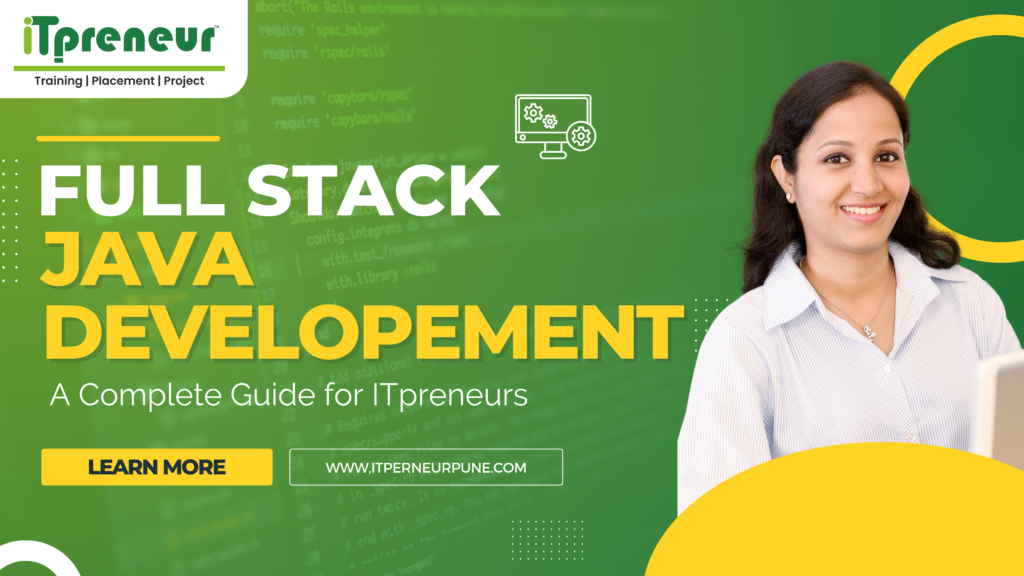
In the fast-paced world of software development, businesses and entrepreneurs are constantly looking for efficient, scalable, and robust solutions. Java has been a dominant force in the software industry for decades, making it a top choice for full-stack development. If you are an ITpreneur looking to build enterprise-grade applications, mastering full-stack Java development is a great investment. This blog explores the key aspects of full-stack Java development, including its advantages, essential tools, frameworks, and best practices. Why Choose Java for Full-Stack Development? Java has been a popular programming language for over two decades, known for its stability, security, and scalability. Here are some reasons why Java is ideal for full-stack development: Understanding Full-Stack Java Development Full-stack development involves working on both front-end and back-end technologies. A full-stack Java developer should be proficient in: Let’s break down the tech stack for full-stack Java development. Front-End Development in Java Full-Stack Though Java is primarily a back-end language, front-end technologies play a crucial role in full-stack development. Here are some essential front-end tools and frameworks: 1. HTML, CSS, and JavaScript These are the fundamental building blocks of web applications. HTML structures the content, CSS styles it, and JavaScript adds interactivity. 2. Angular or React 3. Thymeleaf For Java developers who prefer server-side rendering, Thymeleaf is a popular templating engine that works seamlessly with Spring Boot. Back-End Development in Java Full-Stack The back-end is the core of any full-stack application, handling business logic, database interactions, and server-side operations. 1. Spring Boot Spring Boot is a powerful Java framework that simplifies back-end development. It provides: 2. Hibernate (ORM) Hibernate is an Object-Relational Mapping (ORM) framework that simplifies database interactions by converting Java objects into database tables. It eliminates the need for writing complex SQL queries. 3. Jakarta EE (formerly Java EE) Jakarta EE is a set of specifications for enterprise applications, offering APIs for web services, security, and data processing. It is widely used in large-scale applications. Database Management for Full-Stack Java Developers Handling data efficiently is a crucial aspect of full-stack development. Depending on the application’s needs, developers can choose from relational or NoSQL databases. 1. MySQL & PostgreSQL (Relational Databases) Both databases offer reliability and scalability. They are widely used in enterprise applications. 2. MongoDB (NoSQL Database) MongoDB is a document-oriented NoSQL database, ideal for handling large volumes of unstructured data. It is commonly used in applications that require high flexibility. 3. JPA (Java Persistence API) JPA is a Java specification that simplifies database access using ORM frameworks like Hibernate. API Development and Integration APIs enable seamless communication between different systems. Java developers often use: DevOps and Deployment To ensure smooth deployment and maintenance, full-stack developers should be familiar with DevOps practices. 1. CI/CD Pipelines Continuous Integration and Continuous Deployment (CI/CD) automate testing and deployment processes. Tools like Jenkins, GitHub Actions, and GitLab CI/CD are commonly used. 2. Docker & Kubernetes 3. Cloud Services Java applications can be deployed on cloud platforms like AWS, Google Cloud, and Microsoft Azure for scalability and reliability. Best Practices for Full-Stack Java Development To develop efficient and maintainable applications, follow these best practices: Career and Business Opportunities in Full-Stack Java Development As an ITpreneur, mastering full-stack Java development opens up various opportunities: Conclusion Full-stack Java development is a valuable skill for ITpreneurs, enabling them to build scalable, secure, and high-performance applications. By mastering front-end and back-end technologies, database management, DevOps, and best practices, you can create innovative solutions and expand your business opportunities. Are you ready to embark on your journey as a full-stack Java developer? Start learning today, experiment with projects, and stay updated with the latest industry trends!
Linux + AWS: Learn Cloud Computing for the Modern IT Professional
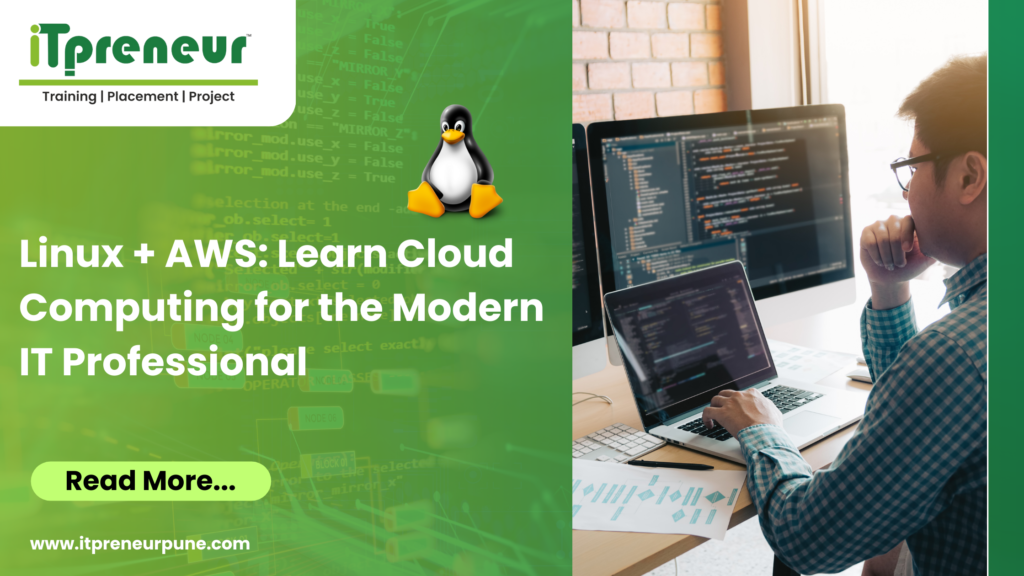
In today’s fast-paced digital world, cloud computing has become essential for businesses of all sizes. Whether you’re part of a large corporation or a startup, leveraging cloud technologies like Linux and Amazon Web Services (AWS) is crucial for scaling operations, enhancing security, and optimizing performance. If you’re looking to future-proof your career in IT and unlock exciting job opportunities, Linux + AWS training is the key. This combination of technologies is especially beneficial for IT professionals who want to lead in cloud computing.Let’s explore why Linux + AWS is such a powerful combo and how it can accelerate your tech career. Why Linux + AWS? The Perfect IT Combo Both Linux and AWS play pivotal roles in the world of cloud computing. Here’s why mastering both is the ultimate skillset for today’s IT professionals: Linux: The Backbone of IT Infrastructure Linux is an open-source operating system that powers the majority of web servers and cloud environments. It’s highly customizable, flexible, and secure, which makes it ideal for managing IT infrastructure. AWS: The Cloud Platform Leader Amazon Web Services (AWS) is the most popular and widely-used cloud platform, providing a comprehensive suite of services such as computing power, storage, networking, machine learning, and more. AWS is essential for businesses looking to build scalable applications, store data, and optimize their infrastructure. The Power of Linux + AWS in Your IT Career Combining Linux with AWS gives you a complete toolkit for cloud infrastructure management. Here’s why this combo is essential for your career growth: What You’ll Learn in a Linux + AWS Course At Itpreneur Institute, we offer a comprehensive Linux + AWS course that will provide you with the skills you need to thrive in the cloud computing world. Here’s what you can expect to learn: Why This Course Will Transform Your Career A Linux + AWS course from Itpreneur Institute equips you with the skills needed to excel in a cloud-based IT career. Here’s how it will help: Conclusion: Start Your Journey Today The future of IT is in the cloud, and Linux + AWS is the skillset that will get you there. If you’re looking to transform your tech career, learning Linux and AWS is the perfect place to start. With Itpreneur Institute‘hands-on training, you’ll gain the practical knowledge and real-world experience needed to become a sought-after cloud professional.
